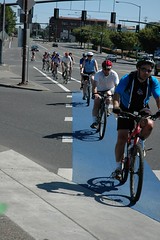The Portland Tribune has published an article about concerns raised by citizens and the Oregon Department of Transportation over the usage, safety and efficacy of the newly installed bike boxes.
The story’s sub-headline reads, “Some cycling advocates are trying to stick a wrench in the spokes of Portland’s new bike box program, saying they’re confusing and inherently unsafe, and should not be approved by the federal government.”
The article focuses primarily on concerns raised by Ryan Conrad (a daily Portland bike commuter and mechanic at the Beaverton Bike Gallery store) and concerns about bike boxes (in certain situations) by ODOT’s head traffic engineer Ed Fischer.
Conrad — the same person quoted by John Schubert in a recent article critical of Portland’s bike lanes — has been a vocal critic of PDOT’s bike box plans (see comments he left on this site back in March here and here). He thinks the new intersection treatment is unsafe, has not been properly analyzed, and opens up PDOT to legal liability because they have not been officially approved as Traffic Control Devices (TCDs) by the Federal Highway Administration (FHWA).
In a comment left on this site, Conrad wrote that he would not be critical of bike boxes “if they are approved TCDs, [are] properly tested and actually can be shown to effectively mitigate ‘right-hook’ accidents,” but added that none of those points “have been demonstrated to be true.”
I spoke with ODOT’s Ed Fischer today and he feels his comments were taken a bit out of context in the Tribune story. He wanted it to be clear that ODOT is not against Portland’s use of bike boxes.
Fischer also pointed out that ODOT only has jurisdiction over state highways that serve higher-speed and higher-volume traffic (and have less bike traffic) — conditions that pose much different considerations for bike boxes than city streets in Portland.
KGW-TV (Portland’s NBC affiliate) noticed the Tribune article and plans to broadcast a similar story tonight.
PDOT’s bicycle coordinator Roger Geller has wasted no time in responding to the Tribune article. He posted a comment below the article on the Tribune’s website where he defends PDOT’s bike box campaign and explains their “experimental” status:
“Our desire is to evaluate this treatment under federal guidance in order to make it available to cities across the country if it proves to be effective. …How else are we to demonstrate the effectiveness of a design that, as the [Tribune] reporter and others mentioned is already a standard traffic feature in most bicyle-friendly European cities, if we don’t use them?”
Geller maintains that PDOT has employed professional researchers at Portland State University to collect before and after data on the bike boxes. Also — in an attempt to counter the claim that the bike boxes are unsafe and lack sufficient research — Geller points out a recent publication by the Transportation Research Board (download PDF here) that concludes bike boxes do improve bike safety (Geller made that research available to Tribune reporter Nick Budnick but it was not included in the story received until after the article was written.)
[For more on PDOT’s vision on how to improve bike safety, read this article by Geller I published back in November.]
Now, let’s back up a bit.
PDOT filed a formal “Request to Experiment” with the FHWA back in January . The application is not a mandatory procedure but it was done to share information about Portland’s plans with the FHWA in hopes that they would consider adding bike boxes to the Manual on Uniform Traffic Control Devices (MUTCD) — an important set of guidelines used by traffic engineers across the country.
Geller and his team at PDOT hope that innovative bike safety measures begun in Portland can be a model that is emulated in other cities — having bike boxes added to the MUTCD could motivate other city engineers to give them a try.
If the FHWA declines to endorse the experiment, the City of Portland is not obligated to remove the bike boxes, nor would PDOT be running afoul of the law if they left them in. According to local bicycle facilities planner Mia Birk, cities have the jurisdictional authority to install traffic control devices that do not have official federal approval.
A similar situation arose when PDOT first installed blue-colored bike lanes back in 1997. A “Request to Experiment” was filed with the FHWA and in that case, the feds did decline to endorse them. PDOT went ahead with their plans and continued to analyze their effectiveness. They partnered up with researchers from North Carolina and published a study showing that the lanes had a positive impact on bike safety. (The blue bike lanes are still in use today.)
As for the bike boxes, Geller says he and city traffic engineer Rob Burchfield are working with the FHWA to address their concerns. “We hope to get to the point where they approve them. We think we have a well-designed, experimental protocol and our desire is to continue to work with them [the FHWA] so we can have a successful experiment.”



